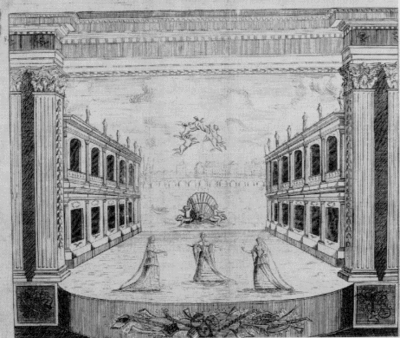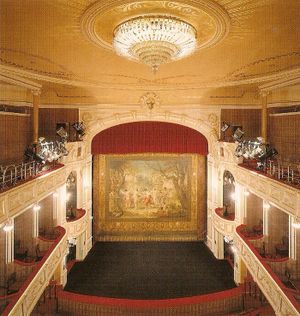Stage (theatre)


In theatre, the stage (sometimes referred to as the deck in stagecraft) is a designated space for the performance of theatrical productions. The stage serves as a space for actors or performers and a focal point for the members of the audience. As an architectural feature, the stage may consist of a platform (often raised) or series of platforms. In some cases, these may be temporary or adjustable but in theaters and other buildings devoted to such productions, the stage is often a permanent feature.
There are several types of stages that vary as to the usage and the relation of the audience to them.[1] The most common form found in the West is the proscenium stage. In this type, the audience is located on one side of the stage with the remaining sides hidden and used by the performers and technicians. Thrust stages may be similar to proscenium stages but with a platform or performance area that extends into the audience space so that the audience is located on three sides. In theatre in the round, the audience is located on all four sides of the stage. The fourth type of stage incorporates created and found stages which may be constructed specifically for a performance or may involve a space that is adapted as a stage.
Contents |
Types of staging
Proscenium stage
Since the Italian Renaissance, the most common stage used in the West has been the proscenium stage which may also be referred to as a picture frame stage. The primary feature is a large arch, the proscenium arch, through which the audience views the performance. The audience directly faces the stage—which is typically raised several feet above front row audience level—and views only one side of the scene. This one side is commonly known as the invisible fourth wall of the scene. The proscenium arch evolved from the proskenium in Ancient Greek theatres. This was the space in front of the skênê or backdrop where the actors actually played.
The first indoor theatres were created in French tennis courts and Italian Renaissance palaces where the newly-embraced principles of perspective allowed designers to create stunning vistas with buildings and trees decreasing in size toward a "vanishing point" on the horizon. Stage floors were raked upward slightly from front to back, in order to contribute to the perspective illusion, and also to make groups of actors more visible to audiences who were at first seated on a flat floor. Subsequently, audience seating was raked, and balconies were added to give audiences a fuller view. By the end of the 19th century most stages had level floors, and much of the audience looked down on, rather than up to, the stage.
The competition among royals to produce elegant and elaborate entertainments fueled and financed the expansion of European court theatres. The proscenium - often extremely decorative in the manner of a triumphal arch, "framed" the prospective picture. The desire of court painters to show more than one of their perspective backgrounds led court architects to adapt the pin-rails and pulleys of sailing ships to the unrolling, or later to the lowering and raising, of canvas backdrops. A wood (and later steel) grid above the stage supported pulleys from which wooden battens, and later steel pipes, rolled down, or descended, with attached scenery pieces. The weight of heavy pieces was counterbalanced by sandbags. This system required the creation of a storage stage house or loft usually as high or higher than the proscenium itself. A "full-fly" stage could store the entire height of visible scenery above the visible stage using the pin-rails before or during performance, where a "half-fly" stage common in smaller locations could store only a limited size of props and thus requires more careful backdrop and scenery design. Theatres using these rope systems operated manually by stage hands are known as hemp houses. They have been largely supplanted by systems using cables and motors.
The proscenium hides the sides of the stage, called the wings, which may be used by theatre personnel working on the particular performance as well as a space for storage of scenery and theatrical properties, typically obscured by side curtains, or framed scenery pieces, called legs. Several rows of short curtains across the top of the stage, called teasers, hide the backdrops which are hidden above in the stage loft until ready for use.

Often, a stage may extend in front of the proscenium arch which offers additional playing area to the actors. This area is a referred to as the apron. Underneath and in front of the apron is sometimes an orchestra pit which is used by musicians during musicals and operas. The orchestra pit may sometimes be covered and used as an additional playing space in order to bring the actors closer to the audience. The stage is often raised higher than the audience. Space above some proscenium stages may include a flyloft where curtains, scenery, and battens supporting a variety of lighting instruments may hang.
The numerous advantages of the proscenium stage have led to its popularity in the West. Many theatrical properties and scenery may be utilized. Backdrops, curtains and lighting can be used to greater effect without risk of rigging being visible to the audience. Entrances and exits can be made more graceful; surprise becomes possible. The actors only have to concentrate on playing to the audience in one direction. The one downfall to a proscenium stage is that it is difficult (though not impossible) to turn it into something else.
Theatre in the round
This method of stage design consists of a stage situated in the centre of the theatre, with the audience facing it from all sides. The audience is placed quite close to the action which provokes a feeling of intimacy and involvement.
In-the-round stages require special considerations in production such as:
- Scenery that does not obscure actors and the rest of the stage from parts of the audience.
- Backdrops and curtains cannot be used, thus the director must find other ways to set the scene.
- Lighting design is more difficult than for a Proscenium stage, since the actor must be lit from all sides without blinding nearby audience members.
- Entrances and exits must be made either through the audience, making surprise entrances very difficult, or via closed-off walkways, which must be inconspicuous. As a result, stage entrances are normally in the corners of the theatre.
- The actors need to ensure that they do not have their backs turned to any part of the audience for long periods of time, in order to be seen and heard clearly.
Thrust stage

A thrust stage is one that extends into the audience on three sides and is connected to the backstage area by its up stage end. A thrust has the benefit of greater intimacy between the audience and performers than a proscenium, while retaining the utility of a backstage area. Entrances onto a thrust are most readily made from backstage, although some theatres provide for performers to enter through the audience using vomitory entrances. An arena, exposed on all sides to the audience, is without a backstage and relies entirely on entrances in the house or from under the stage.
As with an arena, the audience in a thrust stage theatre may view the stage from three or more sides. If a performance employs the fourth wall, that imaginary wall must be maintained on multiple sides. Because the audience can view the performance from a variety of perspectives, it is usual for the blocking, props and scenery to receive thorough consideration to ensure that no perspective is blocked from view. A high backed chair, for instance, when placed stage-right, could create a blind spot in the stage left action.
Created and found spaces
A stage can also be improvised where ever a suitable space can be found. Examples may include staging a performance in a non traditional space such as a basement of a building, a side of a hill or, in the case of a busking troupe, the street. In a similar manner, a makeshift stage can be created by modifying an environment. For example demarcating the boundaries of a stage in an open space by laying a carpet and arranging seating before it.
Additions and modifications
Proscenium and In-The-Round stage types are only the basic templates for stage layout. There are also extras which can be added in order to improve the stage.
- Aprons are pieces of stage added to the front of a proscenium stage which protrude past the proscenium arch, pushing out into the audience in order to make them feel more involved. They provoke a feeling of being more part of the action, rather than just looking at it through a transparent fourth wall (see above). See also thrust stage. Aprons can usually also be removed to uncover the theatre orchestra pit. Thus, it is only used when there is an event not needing an orchestra while taking place (i.e. a concert).
- Boxes are a feature of more modern stage designs in which temporary walls are built inside any proscenium stage, at a slight angle to the original walls, in order to allow audience members located to the left or right of the proscenium (the further out, the larger the angle) to see the entirety of the stage. They enable the creation of rat runs around the back of the stage, which allow cast members to walk between entrances and exits without being seen by the audience.
Stage terminology

The stage itself has been given named areas to facilitate the precise movement and positioning of actors on a stage (see Blocking (stage)).
To an actor facing the audience, "left" and "right" are the reverse of what they are for the audience. To prevent confusion, actors and directors never use the unmarked terms left or right for the sides of the stage. Rather, they use a phrase specifying the viewpoint. The terms "stage left" and "stage right", respectively, denote the sides of the stage that are on the actor's left and right when the actor is facing the audience, while "house left" and "house right" are the reverse, denoting the sides of the stage as viewed by the audience.
Likewise, the meaning of "front" and "back" would be unclear because they depend on perspective. Instead, the term "upstage" is used to denote the part of the stage furthest from the audience or to motion away from the audience, while "downstage" denotes the portion of the stage closest to the audience or to motion in that direction. These terms were common in older theatres due to the elevation of the actual stage deck. Older theatre designs offered the audience a better view of the action by inclining the floor (known as a raked stage), so upstage was actually a higher elevation than downstage.
A raked stage can vary in its incline; the optimal incline is ten degrees, which is ideal for the audience and actor comfort. A dancing surface incline is often different from an acting incline and can vary from three degrees to twenty degrees.